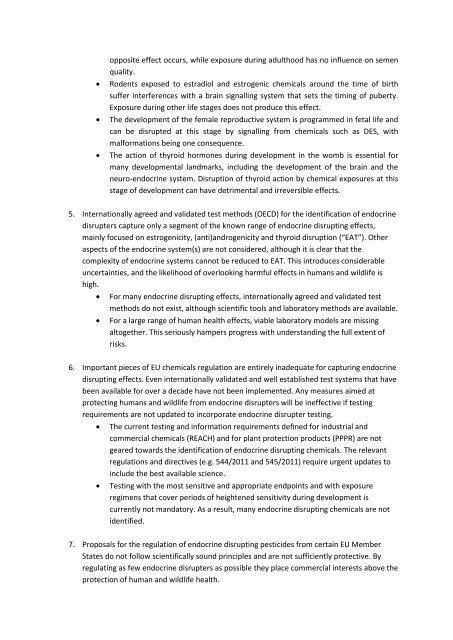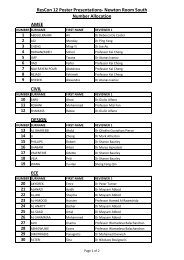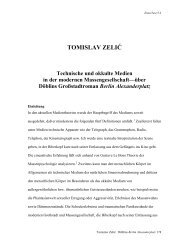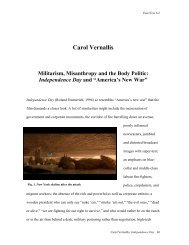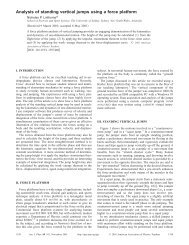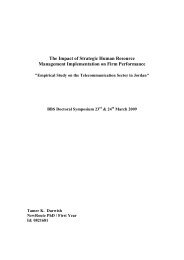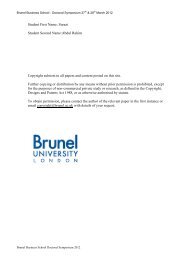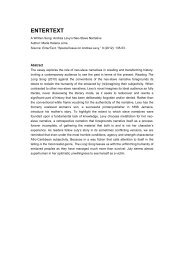The 2013 Berlaymont Declaration on Endocrine ... - Brunel University
The 2013 Berlaymont Declaration on Endocrine ... - Brunel University
The 2013 Berlaymont Declaration on Endocrine ... - Brunel University
Create successful ePaper yourself
Turn your PDF publications into a flip-book with our unique Google optimized e-Paper software.
opposite effect occurs, while exposure during adulthood has no influence <strong>on</strong> semen<br />
quality.<br />
Rodents exposed to estradiol and estrogenic chemicals around the time of birth<br />
suffer interferences with a brain signalling system that sets the timing of puberty.<br />
Exposure during other life stages does not produce this effect.<br />
<str<strong>on</strong>g>The</str<strong>on</strong>g> development of the female reproductive system is programmed in fetal life and<br />
can be disrupted at this stage by signalling from chemicals such as DES, with<br />
malformati<strong>on</strong>s being <strong>on</strong>e c<strong>on</strong>sequence.<br />
<str<strong>on</strong>g>The</str<strong>on</strong>g> acti<strong>on</strong> of thyroid horm<strong>on</strong>es during development in the womb is essential for<br />
many developmental landmarks, including the development of the brain and the<br />
neuro-endocrine system. Disrupti<strong>on</strong> of thyroid acti<strong>on</strong> by chemical exposures at this<br />
stage of development can have detrimental and irreversible effects.<br />
5. Internati<strong>on</strong>ally agreed and validated test methods (OECD) for the identificati<strong>on</strong> of endocrine<br />
disrupters capture <strong>on</strong>ly a segment of the known range of endocrine disrupting effects,<br />
mainly focused <strong>on</strong> estrogenicity, (anti)androgenicity and thyroid disrupti<strong>on</strong> (“EAT”). Other<br />
aspects of the endocrine system(s) are not c<strong>on</strong>sidered, although it is clear that the<br />
complexity of endocrine systems cannot be reduced to EAT. This introduces c<strong>on</strong>siderable<br />
uncertainties, and the likelihood of overlooking harmful effects in humans and wildlife is<br />
high.<br />
For many endocrine disrupting effects, internati<strong>on</strong>ally agreed and validated test<br />
methods do not exist, although scientific tools and laboratory methods are available.<br />
For a large range of human health effects, viable laboratory models are missing<br />
altogether. This seriously hampers progress with understanding the full extent of<br />
risks.<br />
6. Important pieces of EU chemicals regulati<strong>on</strong> are entirely inadequate for capturing endocrine<br />
disrupting effects. Even internati<strong>on</strong>ally validated and well established test systems that have<br />
been available for over a decade have not been implemented. Any measures aimed at<br />
protecting humans and wildlife from endocrine disrupters will be ineffective if testing<br />
requirements are not updated to incorporate endocrine disrupter testing.<br />
<str<strong>on</strong>g>The</str<strong>on</strong>g> current testing and informati<strong>on</strong> requirements defined for industrial and<br />
commercial chemicals (REACH) and for plant protecti<strong>on</strong> products (PPPR) are not<br />
geared towards the identificati<strong>on</strong> of endocrine disrupting chemicals. <str<strong>on</strong>g>The</str<strong>on</strong>g> relevant<br />
regulati<strong>on</strong>s and directives (e.g. 544/2011 and 545/2011) require urgent updates to<br />
include the best available science.<br />
Testing with the most sensitive and appropriate endpoints and with exposure<br />
regimens that cover periods of heightened sensitivity during development is<br />
currently not mandatory. As a result, many endocrine disrupting chemicals are not<br />
identified.<br />
7. Proposals for the regulati<strong>on</strong> of endocrine disrupting pesticides from certain EU Member<br />
States do not follow scientifically sound principles and are not sufficiently protective. By<br />
regulating as few endocrine disrupters as possible they place commercial interests above the<br />
protecti<strong>on</strong> of human and wildlife health.


